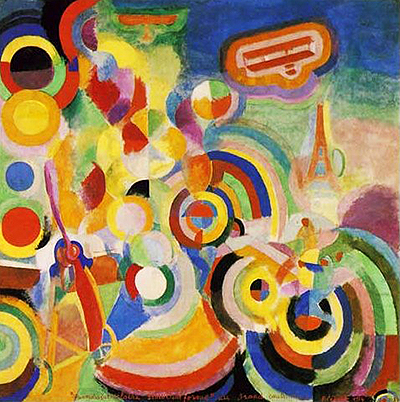Track the rise to prominence of French 20th century painter, Robert Delaunay, in this detailed biography of his life and career highlights.
Introduction
Robert Delaunay became an integral member of the Orphism movement and was famed for his use of geometric shapes with bright tones of colour. He fused together a number of influences found in contemporary art of that period to create something unique, and remains highly regarded today.
Early Life
Robert Delaunay grew up under the care of his wider family after his parents divorced. His uncle encouraged his interest in art, particularly so after he started to struggle academically. An arrangement was made for him to study Decorative Arts in Paris, and so he returned to the city of his birth, after a number of years away.
Robert would spend periods in different parts of France early in his career. This brought him into contact with many different artistic influences, with the early 20th century being a melting pot of different ideas in France. He spent time in the company of other creative minds such as Henri Rousseau and Jean Metzinger.
In his early years one could see a resemblance of Cubism, with fractured forms, similar to a mosaic format. Unlike many other contemporary artists, Delaunay showed an interest in new methods almost immediately, showing little interest in learning the fundamental basics taught by more traditional art forms. There was also a touch of Pointilism within his work, with dabs of paint together forming overall objects within his scenes.
Relationship with Sonia Terk
Sonia Terk would come into Robert's life in around 1908, when he was still in his early evolution as an artist. They would have a profound impact on each other's lives, and marry fairly promptly before having a child in 1911. Delaunay then joined The Blue Rider (Der Blaue Reiter) and started to achieve success abroad, in countries such as Germany and Switzerland.
By this stage, the artist was taking in an extraordinary number of influences amongst young contemporary artists across central and western Europe. Cubism was growing, as were the abstract and expressionist ideas elsewhere, challenging Robert directly to find a way of fusing these exciting methods. His wife Sonia was also an artist, and they could bounce ideas off each other.
Soon afterwards Delaunay would start to distance himself from the Cubist movement, just as it started to expand. He would also start to spend time with the likes of Max Ernst and August Macke, as his first for ideas and artistic relationships grew stronger.
Switch from Spain to France
Robert and Sonia spent the period of WWI in Spain where they found different artistic commissions to keep them financially afloat. Once the war had finished they decided to return to France, where they could start to build relationships with more of the younger generations of artists, which included new movements such as Surrealism and Dadaism.
The artists continued to work effectively in France, before Robert sadly passed away from cancer, soon after the outbreak of WWII. Sonia Delaunay continued to work in France into the 1970s, helping to promote her and her deceased husband's reputations and legacies, which have grown over time and have been aided by her donation of some of their work to notable national galleries.
Style
Robert Delaunay would use bright tones throughout his career, and always worked in a modern manner. He did, however, transition through different influences, and initially bore a rememblance to the Cubist approach, before later making use of geometric shapes with clear lines. The artist was also a skilled draughtsman and fleshed out many of his ideas in pencil and crayon initially, before then creating boldly coloured versions in oil.
In terms of how he might have developed in later life, were he to have survived his bout of cancer, we can take much from the direction taken by his wife, Sonia, who branched out into different methods of expression, as the entire art world opened up in the second half of the 20th century.
Conclusion
The greatest legacy left by Robert Delaunay was in his fusion of different influences found in contemporary art in the early 20th century. His oeuvre spread across Cubism, Neo-Impressionism, Pointilism and so much more, creating a vibrant output which brought him into contact with many of the most exciting young artists in western Europe at that time.




